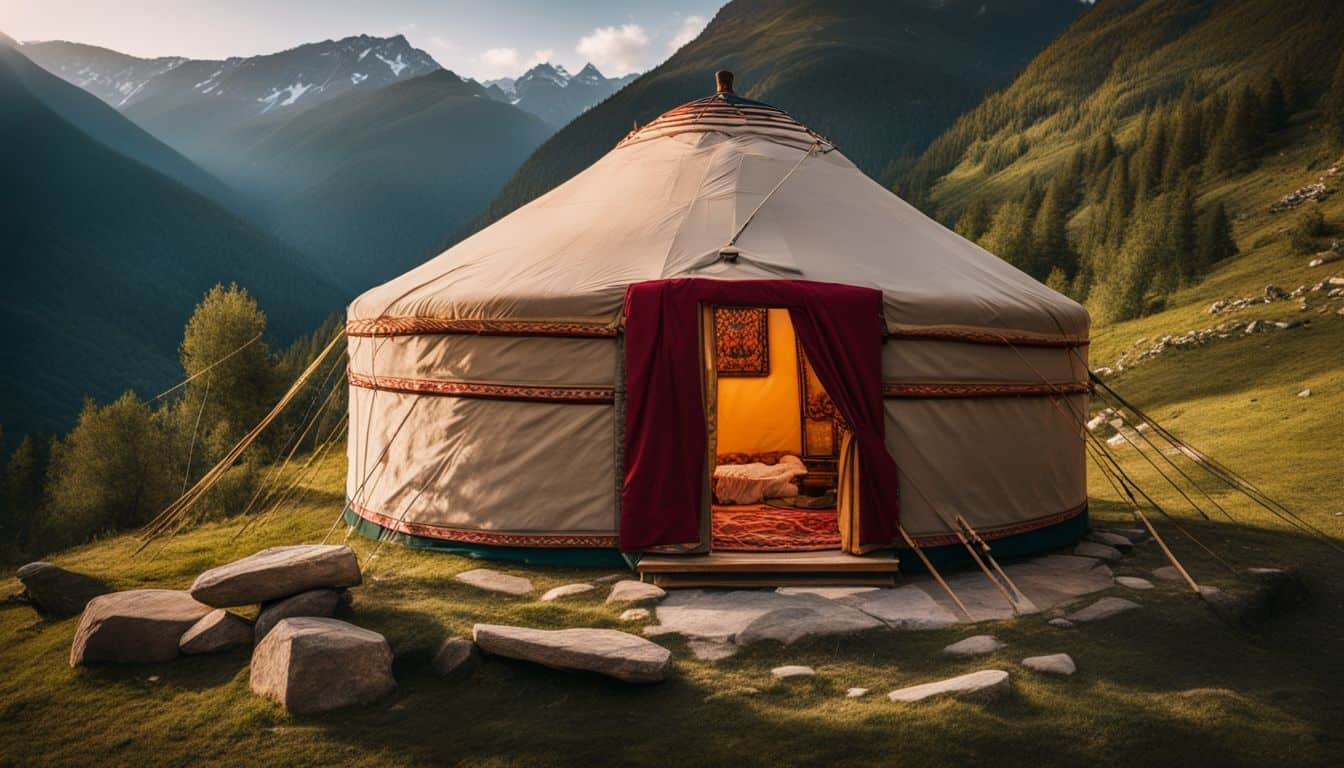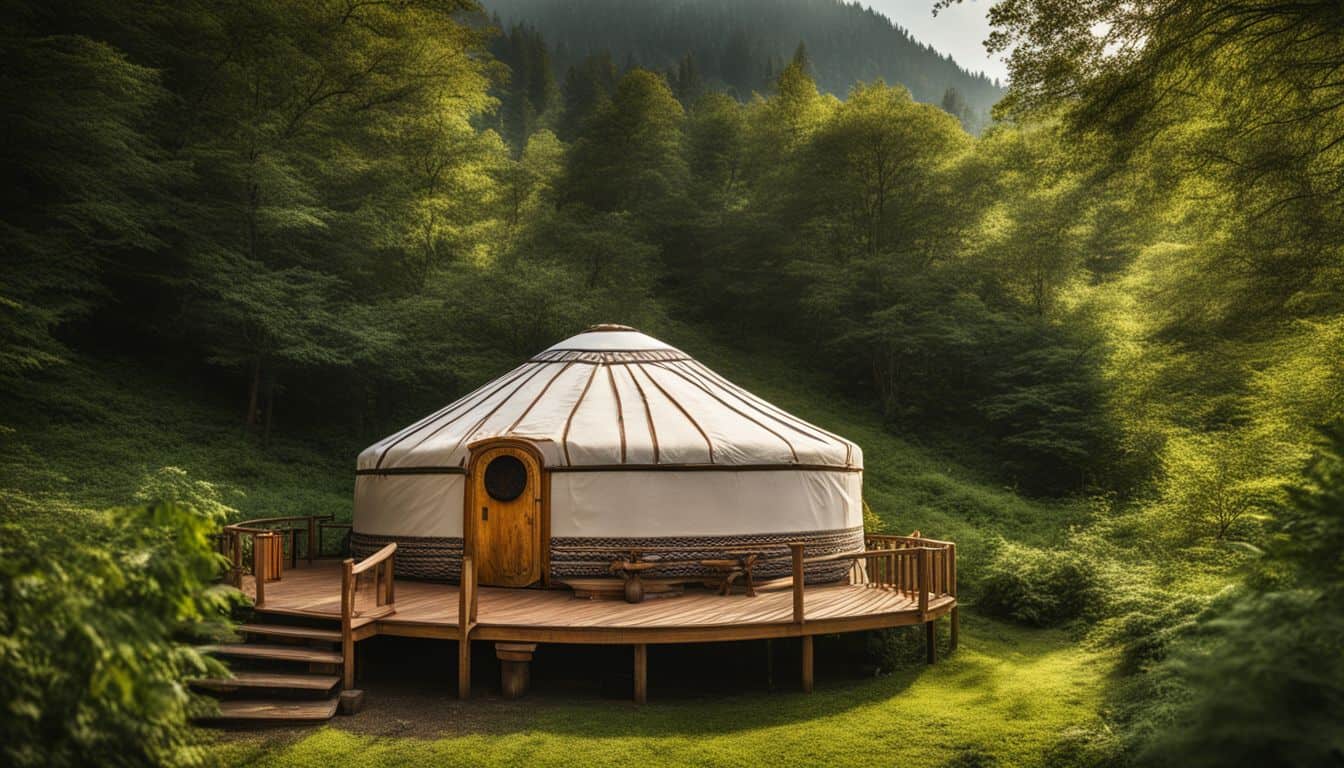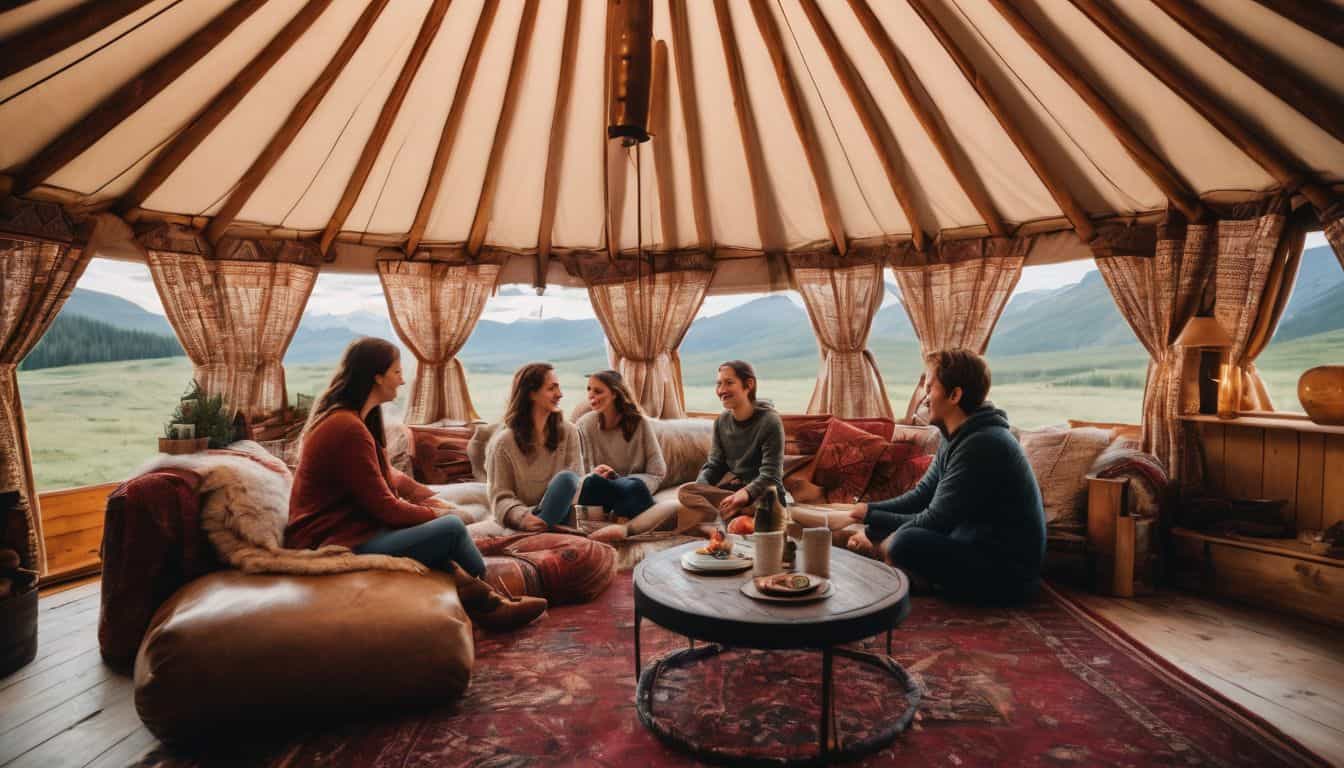The quest for a greener footprint leads many to rethink their living spaces. Enter the yurt: an ancient dwelling that’s making a sustainable comeback. This article will unveil how these versatile structures are shaping the future of eco-friendly housing.
Keep reading, and find out why going round might be just right!
Key Takeaways
- Yurts are ancient homes that use eco-friendly materials like wood, felt, and canvas. Modern yurts include energy-efficient features and stylish designs.
- Building a yurt involves choosing the right piece of land, understanding costs, and assembling all parts. Solar panels and sustainable appliances can be added for greener living.
- Traditional yurts have skylights for natural lighting and round shapes that help with air circulation. Luxury yurts offer modern comforts while being environmentally friendly.
- Sustainable yurt design focuses on harmony with nature using organic materials. They save energy by being efficient in heating and cooling due to their shape.
- Living in a yurt means joining a community that values green living. It shows you can have style and comfort without harming the planet.
Understanding Yurts

Delve into the fascinating world of yurts, versatile dwellings that encapsulate centuries of nomadic tradition yet effortlessly adapt to modern sustainable living. From their origins on the windswept steppes to contemporary eco-havens, these circular homes are an architectural marvel beckoning a deeper exploration.
Traditional or Authentic Yurts
Traditional yurts capture the essence of sustainable living. These round homes have been part of Kazakh culture for centuries, valued for their portability and harmony with nature.
They’re built using eco-friendly materials like wood, felt, and canvas—each piece crafted with care. Felting the wool creates a cozy insulation layer, while wooden frameworks support the structure without harming the environment.
Authentic yurts bring in plenty of natural light through skylights at their center. This design reduces the need for electric lighting during daytime hours. The circular shape isn’t just charming; it helps air circulate efficiently, keeping the space warm or cool as needed.
Nurgissa Architects in Kazakhstan has taken this traditional dwelling to new levels by integrating modern features that honor its nomadic roots yet cater to contemporary needs.
Modern or Stylish Yurts
Moving from the simplicity of traditional yurts, modern ones bring style and innovation to the forefront. Nurgissa Architects in Kazakhstan have taken the classic design and infused it with contemporary features.
These stylish yurts include glued plywood for sturdy walls and flexible polymer film windows that let in natural light while insulating against heat or cold. Transformable furniture inside makes smart use of space, turning a dining area into a bedroom with ease.
Designers focus on eco-friendly materials like basalt fiber for a heat-protective layer, ensuring these homes stay warm in winter and cool in summer. Energy-efficient lighting is standard, cutting down electricity use.
In every corner, modern yurts reflect sustainable living without sacrificing comfort or design flair.
Luxury or Opulent Yurts
Luxury yurts take comfort to the next level. They blend modern amenities with an organic touch, ensuring you stay close to nature without giving up the good stuff. Think of them as cozy sanctuaries that bring a touch of elegance outdoors.
These opulent dwellings are round marvels, offering warmth and inclusivity with their circular design. Picture windows framing the stars above your bed or a kitchen stocked with sustainable energy appliances.
Opulent yurts stand out because they don’t just look good; they work smart, too. They’re self-sufficient homes, equipped with features for saving energy like basalt fiber heat-protective layers and systems for electricity generation that rely on sustainable sources.
Living in one of these means embracing all four seasons gracefully due to their eco-friendly construction and insulation properties. And unlike traditional houses, luxury yurts can adapt to your changing needs while minimizing environmental impact—a win-win situation for both people and the planet.
Now let’s dive into how yurts are revolutionizing eco-friendly homes…
How Yurts Are Revolutionizing Eco-Friendly Homes

As a beacon of sustainability, yurts are transforming the concept of eco-friendly living; their ingenious design marries the ancient wisdom of nomadic lifestyles with the pressing need for environmentally conscious housing in our modern world.
They stand not just as quaint relics from a bygone era but as pioneering structures at the forefront of green home innovation, reshaping how we think about our impact on the planet through dwelling choices.
Sustainable Yurt Design
Sustainable yurt design is all about harmony with the environment. These homes use organic materials like wood and canvas, making them a friend to nature. They are energy-efficient, helping people live off the grid while staying cozy.
The round shape isn’t just pretty; it’s practical, too! It makes heating and cooling easier, which saves power.
Builders of sustainable yurts focus on using resources wisely. They often choose wood from sustainable forestry initiatives for strong frames and breathable canvas walls. This ensures forests stay healthy for future generations.
Plus, these structures can move without hurting the land they leave behind – that’s smart living!
Modern Yurt Structures Inspired By Traditional Nomadic Design
Modern yurt structures blend the best of both worlds — they honor ancient ways while embracing today’s needs. These are not just tents but homes crafted with a deep respect for nature.
You’ll find them made from organic materials like wood and canvas, staying true to their nomadic roots. Designers take cues from the past, creating spaces that feel timeless yet equipped for modern life.
They feature open layouts with natural light pouring in through large windows or skylights.
Builders also add features to meet current demands. Solar panels may sit atop these round dwellings, providing clean energy. Inside, efficient hot water heaters and systems like cradle-to-cradle paper recycling enhance sustainability efforts without sacrificing comfort or style.
Luxury yurts go even further by embroidering elegance into every corner while still being eco-friendly.
Making one of these sustainable structures your home means joining a community that values green living deeply. With each step in building a yurt, you write a new chapter in this age-old story of harmony with the land—next up, finding the perfect spot to plant your roots.
How are Yurts Revolutionizing Eco-Friendly Homes and Modern Learning Environments?
Yurts are revolutionizing modern learning with yurts by providing an eco-friendly and sustainable space for education. These traditional structures are being used as classrooms, offering a natural and inspiring environment for students to learn. With their minimal environmental impact, yurts are an innovative solution for modern educational settings.
The Process of Building a Yurt
Embarking on the journey of constructing a yurt invites an exploration of sustainability and personal craftsmanship. It begins with securing a harmonious slice of land and delving into the details of costs, materials, and building steps—it’s where your eco-friendly haven starts to take shape from concept to reality.
Finding the Right Land
Pick land for your yurt with care. Look for places with enough sunlight and access to water, as these are essentials for eco-friendly living. The right spot will also have natural beauty, giving you a more fulfilling connection to the Earth.
Make sure the site works well with your sustainable goals. You’ll want terrain that supports an autonomous biological system where you can plant gardens or set up solar panels. Check local rules to see if a yurt is allowed, and think about things like privacy and how close neighbors are.
Understanding Yurt Costs and Processes
Yurt prices can surprise you. They range from a few thousand dollars for simple designs to tens of thousands for luxury models with upscale furniture and modern appliances. Building a yurt also means thinking about the land it will sit on.
You need to check zoning laws, get permits, and make sure the land is suitable.
Assembling a yurt is an adventure in itself. Many come as kits from companies like Pacific Yurts, with all the pieces ready to put together. Some people choose to sew their own cover out of canvas or other materials, adding that personal touch.
It might seem tricky at first—like putting together a big puzzle—but many hands make light work! Remember to factor in insulation and energy systems if you’re aiming for self-sufficient living; these are key parts of creating an eco-friendly home with lower bills.
Conclusion
Living in a yurt is like embracing the future while holding hands with the past. These round, eco-friendly homes are changing how we think about sustainable living. They blend old nomadic wisdom with new designs.
Every yurt build shows that going green doesn’t mean giving up style or comfort. This movement towards nature-friendly homes brings us closer to a world where our shelters respect the earth they stand on.
Please check out our article Exploring the History and Cultural Significance of Yurts Across the World.
FAQs
What are yurts and why are they eco-friendly?
Yurts are round tents traditionally used by nomads in Central Asia, but now, they’re cool eco-friendly homes for people looking for a greener lifestyle. They tread lightly on the earth – just imagine a house that could hug the planet!
Can yurts really be as green as other sustainable homes?
You bet! Yurts can be designed cradle to cradle. That means everything from their organic semiconductors in solar panels to clever recycling systems helps cut down waste big time.
Is it hard to keep up with repairs and maintenance on a yurt?
Nope, not at all! In fact, sewing tears in fabric or fixing wood frames is usually simpler than drywall or brickwork repairs. This makes caring for your yurt home easier and keeps things natural.
Do yurts use lots of energy like regular houses do?
Actually, no—they’re pretty smart when it comes to energy use. Thanks to their unique shape and insulation choices, you can stay cozy without using heaps of power—even better if you add solar panels!

Leave a Reply